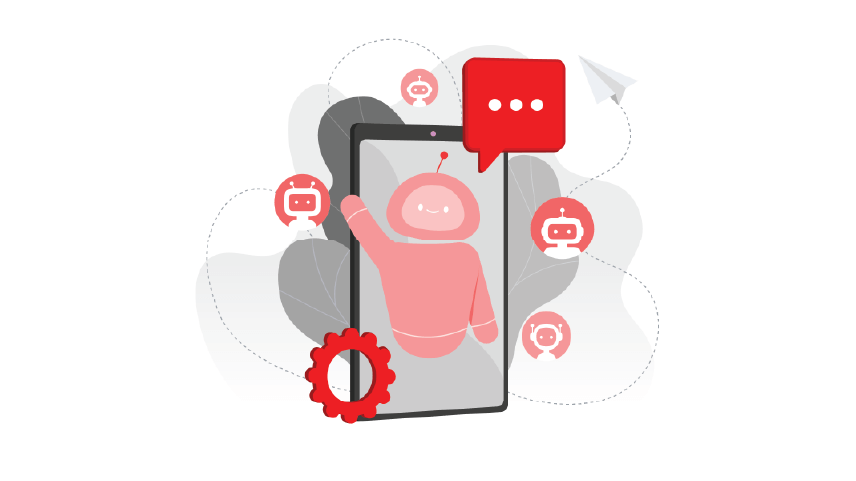Chatbots have become a common application among businesses. They are effective tools that provide 24/7 customer services, which allows staff to focus on value-added and non-repetitive tasks such as resolving a unique customer query. Analysts expect the chatbot market to rise from USD 2.6 billion in 2019 to USD 9.4 billion by 2024.
The rapid progression of technology has produced a wide range of chatbots for myriad purposes, where business leaders can select the most compatible setup according to the vision and function of their organization. Banks, retail companies, and SaaS developers are just some of the many types of organizations that have turned to chatbots for more dynamic communications.
It is essential for businesses to seek the most compatible chatbot that matches the needs of their organization. Choices abound, ranging from simple scripted chatbots to more complex and versatile versions that leverage smart concepts such as AI and NLP. We will look at various types of chatbots to help you discover the perfect fit for your business.
The Core Function of Chatbots
All chatbots function through a two-step process, which involves a user query and a system-generated response. Categories include e-commerce, banking, and retail chatbots. Chatbots have become increasingly popular as they are constantly modified to provide a wide range of benefits, which include enhanced customer experiences, improved operational efficiency, and reduced cost of customer service.
Popular Uses of Chatbots
Chatbots are applied for a wide range of purposes. Support chatbots provide quick and concise answers to the most frequently asked questions. These chatbots will improve the user experience of site visitors. They should be equipped with a break-off feature that enables customers to communicate with a live chat staff when dealing with more complex issues.
Retail chatbots provide visitors with an enjoyable consumer experience. They often engage customers in a fun, energetic, and conversational style, giving the impression of an online friend with a suggestion. These chatbots provide real-time recommendations of products according to a user's recorded preferences and follow-up messages for consumers who abandon their carts. Ultimately, there are infinite possibilities when it comes down to chatbot uses, each driven by several key mechanisms and capabilities.
Driving Forces Behind Chatbots
Chatbot function is driven by several key mechanics that shape consistent responses for every received query. This may be achieved through protocols such as preset structured answers, or through interpreting specific terms within a data library. These mechanics create a seamless flow of realistic conversation derived from a combination of linguistics and computer science.
Rule-based
Rule-based chatbots are some of the most basic forms of chatbot technology. These chatbots respond to a user query based on a preset table of responses set against a strict set of rules. Rule-based chatbots are incapable of "formulating conclusions" from the actions and data of users, relying instead on responding to exact match queries on a one-to-one basis. While rule-based chatbots are limited, they are effective in scenarios where users are seeking quick and accurate assistance.
Artificial Intelligence (AI)
AI is a buzzword that has been dominating the modern digital scene. The AI capabilities stored within a chatbot enables it to record insightful customer behaviors and trends, which enables a fine-tuning of its responses. Over time, the accrued data provides businesses with an accurate overview of consumer behavior, which bolsters existing marketing strategies.
Modern AI programs are usually supported by machine learning (ML), a set of computed algorithms that improve with user experience. As such, chatbots serve a dual-purpose by providing customers with relevant information while collecting valuable insights for businesses.
Natural Language Processing (NLP)
NLP bridges the gap between natural and computer languages. The process essentially “teaches” chatbots to process and analyze large volumes of data that are conveyed in the form of natural languages.
As such, the chatbot software is capable of deriving fundamental meaning from strings of text that are submitted by a customer or user. Effective NLP enables chatbot owners to refine and streamline its responses. NLP is usually implemented by companies that wish to create a uniquely consistent persona or personality for highly conversational chatbots.
These conversational chatbots are capable of picking up spelling errors or shortened words and recognizing their closest meaning. The deep learning capacity of NLP-based chatbots enables businesses to scale their offerings quickly and effectively through insightful conversations with clients.
Keyword Recognition-based
These chatbots function through a combination of AI and keyword recognition capabilities to provide the most suitable answers to a user. Keywords are usually tagged to preset answers that have been customized within the database of the chatbot. For example, if a user were to ask "how much is a pack of cool playing cards for the new year?", the system picks up keywords such as "how much" and "playing cards", which provides a preset answer with the closest match to the original query.

 Business Partner |
Business Partner | 
